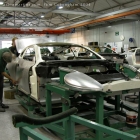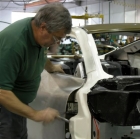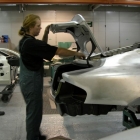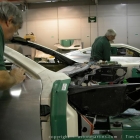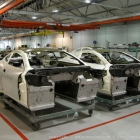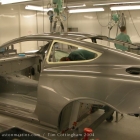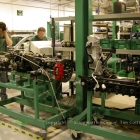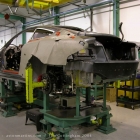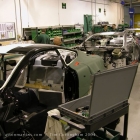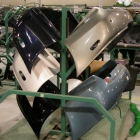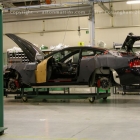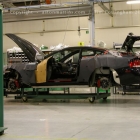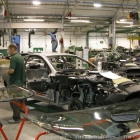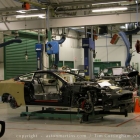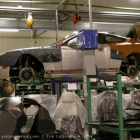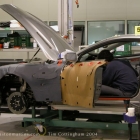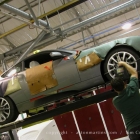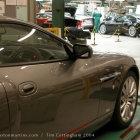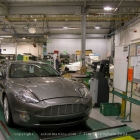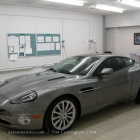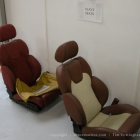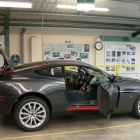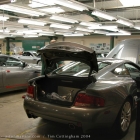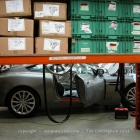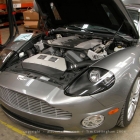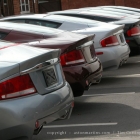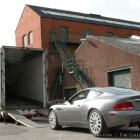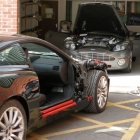I think that these may be the first published of V12 Vanquish production, but not the last. I was fortunate to return in June 2007 and will publish my pictures of the last Astons to be made at Newport Pagnell later in 2008. I will add that organised factory visits are just one benefit of AMOC membership. If you wish to join (you don’t need to own an Aston at all), please visit www.amoc.org for details. Parts Storage This is where the tour begins in the area formally the machine shop for chassis components. This is where the many parts, especially sourced for the Vanquish, many of which originate from within the Ford family. Of course, Aston Martin have a dedicated parts facility in Milton Keynes which means that the Newport Pagnell site doesn’t need to keep too much.
Body panels The V12 Vanquish is similar to previous Astons in that that the body panels are of aluminium alloy. They are initially made by a company called Superform. Their special process called Superforming involves a single sided mould where a heated sheet of aluminium is added. The sheet is then subjected to high pressure which moulds the sheet to the desired shape. These panels are then hand finished in the traditional way in the panel shop. Aston Martin don’t hand finish for sentimental reasons; it’s still the best way to ensure the very best finish of complicated panels. This shop occupies the area formally used for the construction of the chassis of the V8 models. Bonding the panels to the chassis tub, the Bonding Area The V12 Vanquish has an aluminium monocoque (or tub) made by Hydro Automotive Structures in Worcester (now known as Holden Aluminium Worcester) and constructed of extruded aluminium and supplied already bonded by special adhesives. This is similar to that of the DB9, although this is bonded in house at the Gaydon factory. The Vanquish tub also featured carbon fibre components such as the centre tunnel, boot floor and sophisticated ‘A’ posts (windscreen surround). The body panels are fixed into place by special adhesives requiring three jigs. The Paint Shop The most updated part of the factory is the paint shop which has been much enlarged to cope with the increased production. Each car is prepared for painting by hand flatting using a fine grade of abrasive paper. The V12 Vanquish gets nine hand applied coats of paint and lacquer which are hand flatted between coats. The paint shop now has large glass windows which allows visitors a much better view of the painting but still allows for a dust free environment. Aston Martin paint finishes have been regarded as the best in the industry for many years. Modern paints allow for less coats to be applied but the factory are keen to point out that their paint is much thicker than that of other so called premium manufactures (180 microns compared with 70 to 90 for a Jaguar, Mercedes or Porsche). It takes 54 hours to prepare, paint and polish a V12 Vanquish. Production Chassis Area (stations 1100 to 1600) Once painted, the car comes to this area where various items are added at each station. Indeed, this is the same assembly area used for the previous V8 models. Major items are fitted at this time and include the front crash structure with wings and bonnet, suspension, plus the engine and gearbox. Notice that all paint is protected by leather hides to prevent accidental damage. Just before the car moves to the Finishing Line and goes to be trimmed, the engine is started for the first time whilst actually within the car. From the introduction of the V12 Vanquish in 2001, the engines have been built by Cosworth. From 2004 onwards, they are made in a special Aston Martin facility within a Ford engine plant in Cologne, Germany. Final Line (stations 1700 to 2100) The final line is where the V12 Vanquish really comes together. It is during it’s time in this area that the car receives all of it’s interior trim, doors, bonnet, bumpers, glass and eventually wheels too. By station 2000, the Vanquish has it’s wheel and steering alignment checked and at 2100, lamps are adjusted, the ECUs are checked and finally the next to last items are fitted, the windscreen wipers. It appears that the bonnet badge is the last. On these 2003 pictures, the paintwork of the Vanquish is protected by old hides stuck on with tape; by 2006, AM had developed special protective panels to do a better job in a neater way. The Trim Shop It takes eight Scandinavian hides from Bridge of Weir to trim a Vanquish. Whilst the seats are from Recaro, they are trimmed in Newport Pagnell to the high standards expected by Aston Martin customers. Whilst it could be said that the increased mechanisation of the building of the Vanquish has allowed an increase in production, this does not apply to the trim shop area. It appears that a much larger number of people are working in this area than seen during V8 production. It is said to take 78 hours and eight Bridge of Weir hides to trim a Vanquish. The trim shop has been relocated from the old cinema building, across the road, to alongside the rectification area. V12 Vanquish Production at AM Newport Pagnell 2003
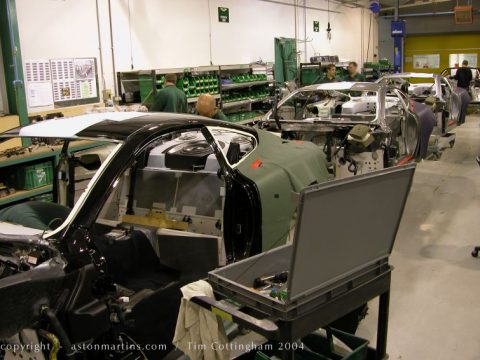
V12 Vanquish Production at AM Newport Pagnell 2003
AMOC members used to be able to visit the factory after a quick telephone call to the then historian and archivist, Roger Stowers, who sadly passed away in 2003. But, in preparation for V12 Vanquish production, factory tours were stopped in late 1998 for all except valued customers. That was until 2003 when the factory allowed just two days per year for factory tours for AMOC members. It was on the tour in October 2003 that I was able to take these photographs with full permission of AML. I may be wrong, but I think that this is the first time that photographs have been published of the construction of the V12 Vanquish. I returned to visit the factory in 2006 and found that photography had been forbidden.
V12 Vanquish Production at AM Newport Pagnell 2003







